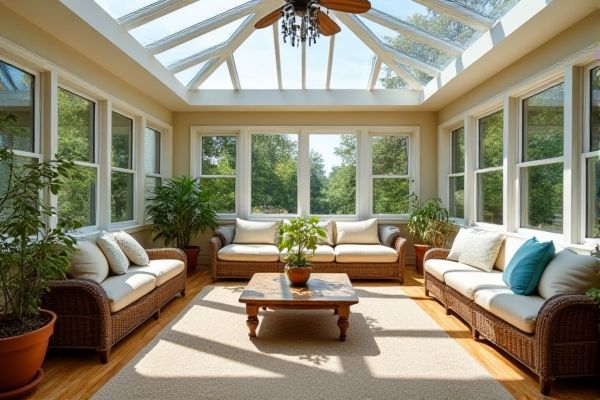
A sunroom is typically an enclosed porch designed to let in sunlight while providing shelter, often constructed with standard windows and integrated into your home's living space, while a solarium is a glass-enclosed room specifically engineered to maximize sunlight exposure, frequently using floor-to-ceiling glass panels. Discover the key differences and benefits of each to determine which option best suits your lifestyle by reading the rest of the article.
Table of Comparison
| Feature | Sunroom | Solarium |
|---|---|---|
| Definition | Enclosed room with large windows for natural light | Glass-enclosed space with transparent roof for maximum sunlight |
| Roof Type | Opaque or solid roof | Glass or transparent roof |
| Purpose | Additional living space, blend indoor-outdoor | Maximize sunlight exposure, often for plants |
| Climate Suitability | Better insulated, usable year-round | Can overheat, requires ventilation or shading |
| Cost | Typically lower cost | Generally higher due to glass roofing |
| Common Uses | Relaxation area, family room, dining space | Greenhouse, sunbathing, tropical plants |
Sunroom vs Solarium: Key Differences
Sunrooms are typically constructed with framed walls and glass windows that provide a comfortable, enclosed space attached to the home, designed for relaxation and year-round use. Solariums distinguish themselves by featuring predominantly glass walls and a glass roof, maximizing natural light and offering panoramic outdoor views while maintaining a greenhouse-like environment. Key differences include the structural design, material usage, and the intended function, with sunrooms emphasizing insulation and comfort, whereas solariums focus on light exposure and plant cultivation.
Structural Design Comparison
Sunrooms typically feature framed walls with large windows and solid roofs constructed from traditional building materials, providing a cozy, insulated space ideal for year-round use. Solariums are characterized by their extensive use of glass walls and a glazed roof, maximizing sunlight exposure and offering a greenhouse-like environment with open sightlines. When choosing the best fit for your home, consider whether you prioritize structural thermal insulation like a sunroom or the expansive sunlight and aesthetic appeal of a solarium.
Natural Light and Indoor Ambiance
Sunrooms emphasize maximizing natural light through large windows and transparent roofs, creating a bright, airy indoor ambiance that closely connects your living space with the outdoors. Solariums often feature glass walls and ceilings designed for optimal sunlight exposure while maintaining temperature control, enhancing warmth and comfort throughout the year. Your choice between a sunroom and a solarium will shape how natural light integrates with your home's atmosphere and energy efficiency.
Climate Control and Insulation
Sunrooms typically feature double-pane glass and insulated frames designed for moderate climate control, making them suitable for year-round use in temperate regions. Solariums, however, often utilize higher-grade glazing materials with advanced thermal insulation and integrated shading systems, providing superior temperature regulation and energy efficiency even in extreme weather conditions. Enhanced climate control in solariums ensures consistent indoor comfort, reducing reliance on HVAC systems compared to traditional sunroom designs.
Cost Considerations: Sunroom vs Solarium
Sunrooms typically cost less to build due to simpler materials like framed glass and standard roofing, with average prices ranging from $15,000 to $35,000. Solariums, featuring floor-to-ceiling glass and aluminum framing, demand higher investment, often between $25,000 and $50,000, because of their intricate design and enhanced insulation properties. When planning your project, factor in long-term energy efficiency and maintenance expenses to determine which option aligns best with your budget.
Maintenance Requirements
Sunrooms typically require less maintenance due to their use of standard building materials such as wood or vinyl framing and double-pane glass, which resist weather damage and are easier to clean. Solariums, with their extensive use of glass on walls and ceilings, demand more frequent cleaning to prevent dirt buildup and specialized maintenance to address potential issues like leaks and seal degradation. Both structures benefit from regular inspections, but solariums' complex glazing systems often necessitate higher upkeep and professional attention to maintain transparency and structural integrity.
Energy Efficiency and Sustainability
Sunrooms often feature traditional windows and framing, which can result in less energy efficiency compared to solariums designed with advanced glazing and insulated materials to maximize solar heat gain and reduce energy loss. Solariums incorporate high-performance glass and airtight seals that improve thermal insulation, lowering heating and cooling costs while enhancing sustainability by reducing reliance on external energy sources. Consider your climate and energy goals when choosing between a sunroom and solarium to optimize your home's environmental footprint and energy performance.
Best Uses and Functions for Each Space
Sunrooms offer a versatile indoor-outdoor living space ideal for relaxation, casual dining, and casual social gatherings thanks to their large windows that maximize natural light while maintaining insulation. Solariums focus on maximizing solar exposure with glass roofs and walls, making them perfect for growing plants year-round, enjoying sunlight during colder months, and serving as bright greenhouse environments. Both spaces enhance home value and comfort but are optimized for distinct purposes--sunrooms for leisure and social use, solariums for botanical cultivation and passive solar heating.
Property Value Impact
Sunrooms and solariums both enhance property value by increasing usable living space and natural light, but solariums typically add greater appeal due to their full glass design that offers panoramic outdoor views. A sunroom, with its solid roof and framed windows, provides more insulation, making it a practical year-round addition that can attract buyers seeking comfort and energy efficiency. Your choice between the two impacts resale potential, with solariums often commanding a premium for their aesthetic and lifestyle benefits, while sunrooms contribute steady, reliable value.
Choosing the Right Option for Your Home
Selecting between a sunroom and a solarium depends on your home's architectural style, climate, and intended use. Sunrooms typically feature solid roofs with large windows, offering year-round usability and enhanced insulation, while solariums have glass roofs designed to maximize natural light and solar heat gain. Consider energy efficiency, maintenance requirements, and personal preferences to determine which structure best complements your living space and lifestyle.
 homyna.com
homyna.com